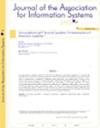Be Together, Run More: Enhancing Group Participation in Fitness Technology
IF 5.5
3区 管理学
Q1 COMPUTER SCIENCE, INFORMATION SYSTEMS
引用次数: 0
Abstract
Individuals are increasingly using novel fitness technologies, such as running applications (apps), to support their workouts. The literature has primarily focused on the use of fitness apps at the individual level (i.e., to improve individuals’ exercise levels) and few studies have investigated the role of fitness apps in facilitating group exercise. Consequently, there is a paucity of information on how to enhance the exercise participation of individuals using fitness apps through the use of groups (i.e., how to entice more individuals to engage in exercise). We selected a running app as the context and focused on a particular feature of this app called “Running Spot,” which facilitates members’ offline group engagement, a topic that has thus far received scant attention in the literature. Drawing on the perspective of psychological distance and relational cohesion theory, we propose that the Running Spot feature facilitating offline group engagement improved group participation in running. To advance this line of research, we utilized a panel dataset of 151 running groups from the running app platform over a period of 38 weeks. The aim was to empirically evaluate the effects of offline group engagement facilitation (e.g., Running Spot) using a combination of the difference-indifferences approach and the propensity score matching technique. Our findings suggest that Running Spot indeed promoted groups’ participation in running. Furthermore, the impact of Running Spot was magnified with smaller groups and groups that were moderately closely located to the designated running spots. Our study contributes to the growing body of knowledge on fitness technologies by revealing ways to support group participation and uncovering the complex impact of offline group engagement facilitation (e.g., Running Spot). Our study has important implications for fitness app developers in that it demonstrates that features facilitating offline group engagement should be prioritized to improve group participation in fitness activities.聚在一起,多跑一跑:增强健身技术的群体参与
个人越来越多地使用新的健身技术,如跑步应用程序(app),来支持他们的锻炼。文献主要集中在个人层面上使用健身应用程序(即提高个人的运动水平),很少有研究调查健身应用程序在促进群体运动中的作用。因此,关于如何通过使用群组来提高个人使用健身应用的运动参与度(即如何吸引更多的个人参与运动)的信息缺乏。我们选择了一款跑步应用作为背景,并专注于这款应用的一个名为“跑步点”(running Spot)的特殊功能,它可以促进成员的离线小组参与,这是一个迄今为止在文献中很少受到关注的话题。从心理距离和关系凝聚力理论的角度,我们提出跑步点特征促进线下群体参与提高了群体参与。为了推进这一研究,我们利用了来自跑步应用平台的151个跑步组的面板数据集,历时38周。本研究的目的是利用差异-无差异方法和倾向得分匹配技术相结合的方法,对离线群体参与促进(例如,Running Spot)的效果进行实证评估。我们的研究结果表明,跑步点确实促进了团体跑步的参与。此外,跑步点的影响在较小的组和适度靠近指定跑步点的组中被放大。我们的研究揭示了支持群体参与的方法,揭示了线下群体参与促进的复杂影响(例如,Running Spot),从而为不断增长的健身技术知识体系做出了贡献。我们的研究对健身应用开发者具有重要意义,因为它表明,促进线下群体参与的功能应该优先考虑,以提高健身活动的群体参与度。
本文章由计算机程序翻译,如有差异,请以英文原文为准。
求助全文
约1分钟内获得全文
求助全文
来源期刊

Journal of the Association for Information Systems
工程技术-计算机:信息系统
CiteScore
11.20
自引率
5.20%
发文量
33
审稿时长
>12 weeks
期刊介绍:
The Journal of the Association for Information Systems (JAIS), the flagship journal of the Association for Information Systems, publishes the highest quality scholarship in the field of information systems. It is inclusive in topics, level and unit of analysis, theory, method and philosophical and research approach, reflecting all aspects of Information Systems globally. The Journal promotes innovative, interesting and rigorously developed conceptual and empirical contributions and encourages theory based multi- or inter-disciplinary research.
 求助内容:
求助内容: 应助结果提醒方式:
应助结果提醒方式:


